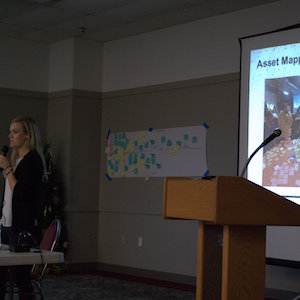 A participant helps place assets and improvement needs on a map during a participatory asset mapping session. ©Natural Hazards Center/Haorui Wu, 2018.
A participant helps place assets and improvement needs on a map during a participatory asset mapping session. ©Natural Hazards Center/Haorui Wu, 2018.
When responding to a disaster, it’s good to know what all partners bring to the table—especially in the case of those who provide assistance to children and their families. That’s why the Natural Hazards Center is excited to support Save the Children with their Building State Voluntary Organizations Active in Disasters (VOAD) Capacities to Protect Children in Emergencies project.
To assist the project—which aims to make emergency management agencies and VOADs more aware and better able to meet the needs of children in disaster—Natural Hazards Center researchers Jamie Vickery and Haorui Wu facilitated discussions focused on children’s needs throughout the disaster lifecycle and opportunities for collaboration. The sessions, which were conducted in Nebraska and Arkansas, used a participatory asset mapping approach to help organizations see the big picture of their assets and areas for improvement in child-centered disaster services.
Those attending—which included state-level VOAD members, state and county-level emergency managers, child-service organizations, and other stakeholders—listed child-focused assets that included specialized training and knowledge, childcare kits and child-friendly foods for shelter situations, partnerships with childcare facilities and schools, youth preparedness groups, and child search capacity. They also identified gaps that included funding, organizational capacity, lack of partnerships, child-specific disaster programs, child-focused mental health resources, and parent communication plans.
 Natural Hazards Center Research Associate, Jamie Vickery, explains asset mapping at a December 2018 meeting. ©Natural Hazards Center/Haorui Wu, 2018.
Natural Hazards Center Research Associate, Jamie Vickery, explains asset mapping at a December 2018 meeting. ©Natural Hazards Center/Haorui Wu, 2018.
Next, the physical locations of assets and gaps were put on a map, in some cases revealing wide swaths of the states with limited capacity to address the needs of children in disasters. In others, a wealth or overlap of resources were identified. Participants then engaged in group discussions about potential solutions and collaborations that might strengthen their ability to better serve children.
“This activity provided an opportunity for participants to learn more about other organizations in their respective states and where their organizations fit in the disaster service landscape,” Vickery said. “These discussions were also critical for us as researchers as we continue to build an understanding of the unique hazards and disasters service contexts within each state.”
Outcomes from the activities resulted in new connections between participants, identification of areas for improvement and potential ways to leverage assets across state VOAD and non-VOAD organizations.
By discussing clusters of assets and areas with little to no assets—including logistical challenges associated with gap areas—these activities spurred cross-organizational connections that can be used to strengthen state VOAD capability to prepare for, respond to, and recover from disasters.
The team is now conducting a social network analysis to better understand and measure levels of interaction between organizations within each state-level VOAD. Findings from these surveys will help Save the Children refine its efforts to build VOAD capacity to protect children in disasters. Ultimately, the findings will also be used to help improve and continue state-level work for children in emergencies throughout the country. A comprehensive report on all activities will be included as part of the project evaluation and is expected sometime in late 2020.